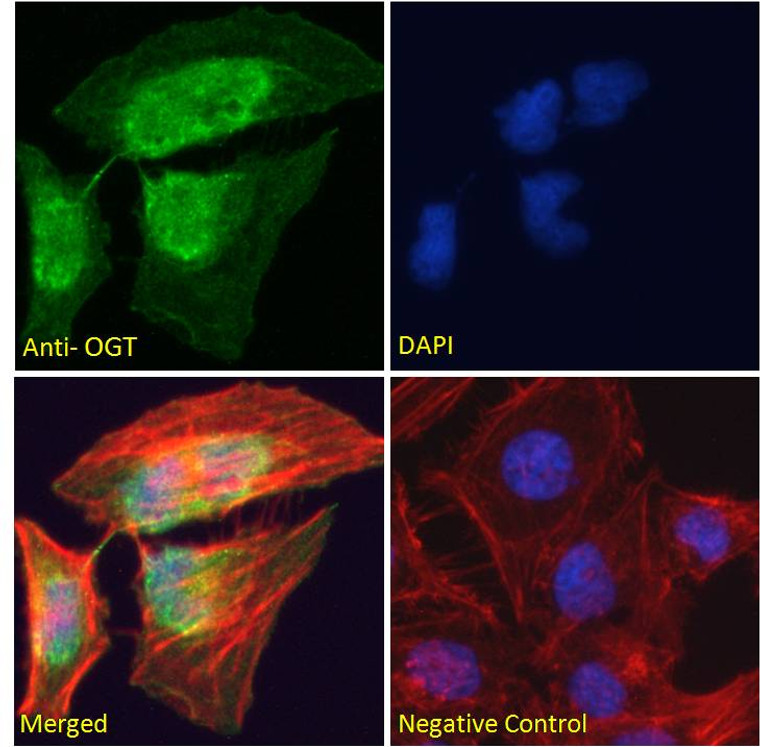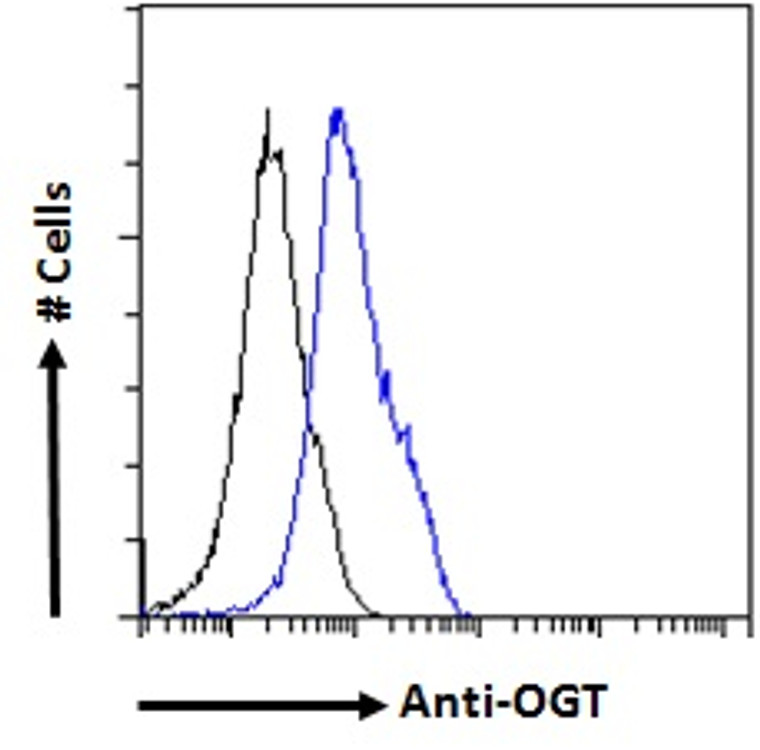| Host: |
Goat |
| Applications: |
Pep-ELISA/WB/IHC/IF/FC |
| Reactivity: |
Human/Mouse/Rat/Dog/Cow |
| Note: |
STRICTLY FOR FURTHER SCIENTIFIC RESEARCH USE ONLY (RUO). MUST NOT TO BE USED IN DIAGNOSTIC OR THERAPEUTIC APPLICATIONS. |
| Short Description: |
Goat polyclonal antibody anti-OGT (Internal) is suitable for use in ELISA, Western Blot, Immunohistochemistry, Immunofluorescence and Flow Cytometry research applications. |
| Clonality: |
Polyclonal |
| Conjugation: |
Unconjugated |
| Isotype: |
IgG |
| Formulation: |
0.5 mg/ml in Tris saline, 0.02% sodium azide, pH7.3 with 0.5% bovine serum albumin. NA |
| Purification: |
Purified from goat serum by ammonium sulphate precipitation followed by antigen affinity chromatography using the immunizing peptide. |
| Concentration: |
0.5 mg/mL |
| Dilution Range: |
IHC-5µg/mlIF-Strong expression of the protein seen in the nucleus of HeLa, U2OS and Glioblastoma U251 cells. 10µg/mlELISA-antibody detection limit dilution 1:64000. |
| Storage Instruction: |
Store at-20°C on receipt and minimise freeze-thaw cycles. |
| Gene Symbol: |
OGT |
| Gene ID: |
8473 |
| Uniprot ID: |
OGT1_HUMAN |
| Immunogen Region: |
Internal |
| Accession Number: |
NP_858058.1; NP_858059.1 |
| Specificity: |
This antibody is expected to recognise both reported isoforms (NP_858058.1 and NP_858059.1 |
| Immunogen Sequence: |
YEHPKDLKLSDGR |
| Post Translational Modifications | Ubiquitinated, leading to its proteasomal degradation. Phosphorylation on Ser-3 or Ser-4 by GSK3-beta positively regulates its activity. |
| Function | Catalyzes the transfer of a single N-acetylglucosamine from UDP-GlcNAc to a serine or threonine residue in cytoplasmic and nuclear proteins resulting in their modification with a beta-linked N-acetylglucosamine (O-GlcNAc). Glycosylates a large and diverse number of proteins including histone H2B, AKT1, ATG4B, EZH2, PFKL, KMT2E/MLL5, MAPT/TAU, NOD2 and HCFC1. Can regulate their cellular processes via cross-talk between glycosylation and phosphorylation or by affecting proteolytic processing. Probably by glycosylating KMT2E/MLL5, stabilizes KMT2E/MLL5 by preventing its ubiquitination. Involved in insulin resistance in muscle and adipocyte cells via glycosylating insulin signaling components and inhibiting the 'Thr-308' phosphorylation of AKT1, enhancing IRS1 phosphorylation and attenuating insulin signaling. Involved in glycolysis regulation by mediating glycosylation of 6-phosphofructokinase PFKL, inhibiting its activity. Component of a THAP1/THAP3-HCFC1-OGT complex that is required for the regulation of the transcriptional activity of RRM1. Plays a key role in chromatin structure by mediating O-GlcNAcylation of 'Ser-112' of histone H2B: recruited to CpG-rich transcription start sites of active genes via its interaction with TET proteins (TET1, TET2 or TET3). As part of the NSL complex indirectly involved in acetylation of nucleosomal histone H4 on several lysine residues. O-GlcNAcylation of 'Ser-75' of EZH2 increases its stability, and facilitating the formation of H3K27me3 by the PRC2/EED-EZH2 complex. Regulates circadian oscillation of the clock genes and glucose homeostasis in the liver. Stabilizes clock proteins BMAL1 and CLOCK through O-glycosylation, which prevents their ubiquitination and subsequent degradation. Promotes the CLOCK-BMAL1-mediated transcription of genes in the negative loop of the circadian clock such as PER1/2 and CRY1/2. O-glycosylates HCFC1 and regulates its proteolytic processing and transcriptional activity. Regulates mitochondrial motility in neurons by mediating glycosylation of TRAK1. Glycosylates HOXA1. O-glycosylates FNIP1. Promotes autophagy by mediating O-glycosylation of ATG4B. Isoform 2: The mitochondrial isoform (mOGT) is cytotoxic and triggers apoptosis in several cell types including INS1, an insulinoma cell line. |
| Protein Name | Udp-N-Acetylglucosamine--Peptide N-Acetylglucosaminyltransferase 110 Kda SubunitO-Glcnac Transferase Subunit P110O-Linked N-Acetylglucosamine Transferase 110 Kda SubunitOgt |
| Database Links | Reactome: R-HSA-3214847Reactome: R-HSA-5213460Reactome: R-HSA-5675482Reactome: R-HSA-5689603Reactome: R-HSA-9772755 |
| Cellular Localisation | NucleusCytoplasmPredominantly Localizes To The NucleusIsoform 2: MitochondrionMembraneAssociates With The Mitochondrial Inner MembraneIsoform 3: CytoplasmCell MembraneMitochondrion MembraneCell ProjectionMostly In The NucleusRetained In The Nucleus Via Interaction With Hcfc1After Insulin InductionTranslocated From The Nucleus To The Cell Membrane Via Phosphatidylinositide BindingColocalizes With Akt1 At The Plasma MembraneTrak1 Recruits This Protein To MitochondriaIn The Absence Of Trak1Localizes In Cytosol And NucleusIsoform 4: Cytoplasm |
| Alternative Antibody Names | Anti-Udp-N-Acetylglucosamine--Peptide N-Acetylglucosaminyltransferase 110 Kda Subunit antibodyAnti-O-Glcnac Transferase Subunit P110 antibodyAnti-O-Linked N-Acetylglucosamine Transferase 110 Kda Subunit antibodyAnti-Ogt antibodyAnti-OGT antibody |
Information sourced from Uniprot.org
12 months for antibodies. 6 months for ELISA Kits. Please see website T&Cs for further guidance











